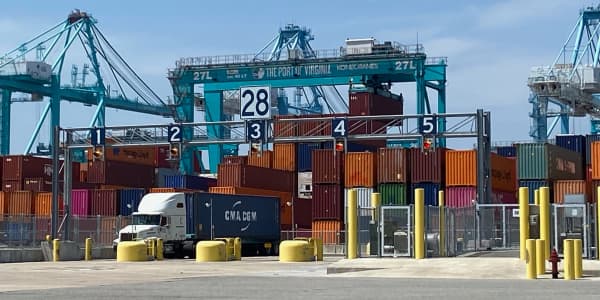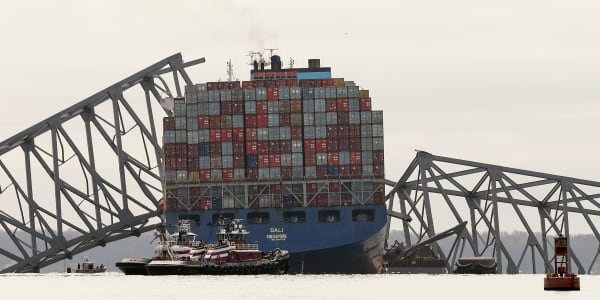The transports industry remains under a cloud of uncertainty. The Covid boom fueled a major stock rally, but it was followed by a freight recession, overcapacity in ocean shipping and trucking, and now a sector rebound in a strong economy. All the companies involved in the movement of global trade are navigating a multitude of headwinds in 2024: dwindling freight orders, the entrance of new vessels, drought-related delays at the Panama Canal, Red Sea diversions that could linger into the second half of the year, and the threat of a strike at East Coast ports.
The Dow Jones Transportation Average is flat this year but has gained 7.6% in the past 12 months through the end of February. The lesson for investors should be to focus on the long game with transport companies, according to a new report from consulting firm AlixPartners.
"Ocean carriers and trucking companies are down from 'unreasonable highs' but based on the history of some of these companies, there are gems in the beaten-down sector that can withstand and survive," said Marc Iampieri, global co-leader of the shipping and logistics & infrastructure practice at AlixPartners and one of the report's authors. "There will be weak players that go away during this time but for companies who have cash to burn, they are better be able to weather the storm. Cash buys optionality."
Iampieri, who works with Fortune 100 companies, said investors need to look at the sector historically, and remember that the freight industry is a cyclical business so needs to be evaluated in terms of longer time horizon prospects.
"Sometimes we get too short-sighted," he said. "Investors need to look at the big picture and see how companies will manage through the lower volumes. You have to remember how resilient these companies have been over the last couple of years."
Loading chart...
The sector experienced it shares of downs in 2023, with widespread layoffs and bankruptcies, from the demise of Yellow to issues at heavily funded startups using technology to disrupt the sector, including Convoy, a logistics startup backed by Jeff Bezos that went under, and at Flexport, where there was a 20% workforce reduction and a high-profile executive split that saw a CEO recruited from Amazon depart.
The fixed tech costs combined with a freight recession, pressured margins, and higher wages add to a company's cost structure, and those are reasons investors need to look at companies with real assets with tangible value, Iampieri said. "Technology helps logistics managers make their decision by giving them visibility into their supply chain, but technology and its maintenance, even by a third party- becomes a fixed cost," he said. "They have become so high now and they can't scale it down."
Third-party logistics providers, the companies that are outsourced partner handling logistics processes and order fulfillment for other businesses, and freight forwarders, companies that work on behalf of a shipper, must forge closer ties to ocean carriers, according to the report.
"In some cases, those relationships will develop into acquisitions; in others, partnerships and strategic agreements will be the keys to building resiliency and maintaining profitability. Short-term rate volatility will continue to benefit subsectors that thrive on uncertainty, such as brokers," the report stated.
Ocean carrier cash reserves and outlook
Ocean carrier reserves increased greatly during the pandemic due to the soaring rates and massive amounts of freight being moved. During 2022-2023, ocean carriers used some of those reserves for their own buying sprees to expand their footprints. Dividends also increased. Historic profits were also used to build and add to their vessel fleets.
"Ocean carriers have so much cash they could be doing deals at a much lower valuation because of poor balance sheet management of other companies," Iampieri said. "Ocean carriers can scoop up and buy these companies for a song."
Major shipping companies have issued cautious outlooks to investors, led by Maersk, but Iampieri tells CNBC that the shipping disruptions in the Red Sea are a tailwind for the sector. While adding to the ocean carrier bunker fuel costs, they are being compensated..
"The Red Sea diversions are a good thing for ocean carriers. I am more bullish on the carriers than we have ever been. Why? The longer route benefits them. If there was no war, rates would be down substantially," he said.
The big question mark is the duration of the diversions and the surcharges the ocean carriers can charge.
"This is an opportunity for them to recover their incremental costs and then some," Iampieri said. "As long as you can get those fees it is accretive. It's a positive if it lasts a year."
Ocean freight rates have been on the decline after a short-term peak due to the Red Sea issues, first in Europe followed by North America. According to Freightos, transatlantic rates increased 54% since mid-December to $1,862/40-foot container last week, but some carriers are postponing additional planned surcharges. Asia to the East Coast of North America is the costlier route compared to the West Coast, and with new ocean contracts being signed next week, shippers will have to factor in the slower travel and the threat of a labor strike at the East Coast ports to decisions.
While the rate increases may be short-lived, that does not mean shippers should be complacent. "Shippers seeking to de-risk their operations and mitigate the impact of higher rates will need to reduce their dependence on ocean transport — and that calls for a Plan B," the report said.
That plan B could be moving freight back to the West Coast.
During the labor strife on the West Coast and massive port congestion during the pandemic, shippers moved more freight to the East Coast and Gulf of Mexico ports. Those two regions have steadily taken market share away from the West Coast ports, with shippers also benefitting from investments in ports infrastructure. But the West Coast will receive more volume of trade.
Paul Brashier, vice president of drayage and intermodal at ITS Logistics, said it is anticipating at least 25% more containers going into the ports of Los Angeles and Long Beach.
"They are looking for additional capacity for ground storage and cross-docking," Brashier said. "As we go into contract season, customers that are planning on the Non-Vessel-Operating Common Carrier (NVO) and carrier side are looking for additional space to store containers."
"The West Coast ports have strengthened infrastructure," Iampieri said. "Volumes will not be what they were during the pandemic and freight rates are lower compared to the East Coast."
Even though the market has cooled since the blistering days of 2021-22, there is opportunity for equity investors seeking both short-term rewards and long-term value plays, according to AlixPartners' report:
"Fixed-income investors will find distressed debt opportunities. And now that earnings multiples have returned to earth and cash remains plentiful, financial investors and strategic acquirers alike are on the hunt, contributing to what's likely to be a lively deal flow in 2024 and 2025. The most salient risks are the uncertain macroeconomic outlook, and global geopolitical tensions."






